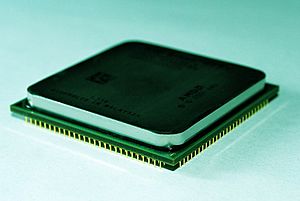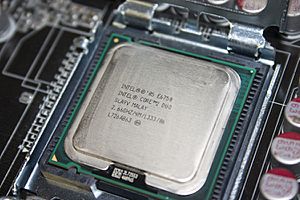Multi-core processor facts for kids

A multi-core processor is like having more than one brain inside your computer's main chip. This special CPU has two or more sections, called "cores." Each core works like its own tiny computer, handling tasks and following instructions. Even though they work separately, all these cores are built onto one single chip. They work together to make your computer faster and more efficient.
For example, a dual-core processor has two independent cores. A quad-core processor has four independent cores. The name of the processor often tells you how many cores it has, based on its prefix.
Contents
What Are Multi-Core Processors?
Until about 2005, most computers used single-core processors. This meant they only had one "brain" to do all the work. Since then, multi-core processors have become much more common. They allow computers to handle many tasks at the same time, which is very helpful for modern software and games.
Why Multi-Core Processors Are Great
Having a multi-core processor in your computer offers several cool benefits:
- Faster Performance: Your computer can run certain programs much faster. This is because different parts of a program can be handled by different cores at the same time.
- Less Heat: Multi-core processors can sometimes run cooler than single-core ones. This is because they can share the workload, or even turn off parts they don't need.
- Saves Power: Since they can turn off unused sections, multi-core processors can use less electricity. This is good for laptops, as it helps their batteries last longer.
- More Features: With more processing power, computer makers can add more advanced features to their devices.
- Better Communication: The different cores are very close together on the same chip. This means they can send information to each other very quickly, making them work together smoothly.
Things to Know About Multi-Core Processors
While multi-core processors are awesome, there are a few things to keep in mind:
- Not Double the Speed: A dual-core processor won't make your computer exactly twice as fast. It usually gives you about 60-80% more speed. The actual speed boost depends on what you're doing.
- Software Matters: The speed you get also depends on the software you are using. Some programs are designed to use multiple cores, while others might only use one.
- Higher Cost: Multi-core processors usually cost more money than single-core ones.
- Heat Management: Because they pack more power into a small space, multi-core processors can be a bit trickier to keep cool.
- Operating System Support: Not all operating systems can use more than one core. However, most modern ones do.
- Single-Core Performance: If an operating system is made for multi-core processors, it might run a little slower on a very old single-core computer.
Operating Systems That Support Multi-Core Processors
Most modern operating systems are built to work well with multi-core processors. Here are some examples:
- Microsoft Windows (Windows XP and newer versions)
- Linux
- Mac OS X
- Most BSD-based systems
- Solaris
The Future of Processors
In the coming years, we will likely see even more multi-core processors. They offer great speed and can still be improved a lot. While multi-core processors are becoming the standard, there will still be a need for single-core processors in some simpler systems that don't require a lot of speed.
Images for kids
See also
 In Spanish: Procesador multinúcleo para niños
In Spanish: Procesador multinúcleo para niños



